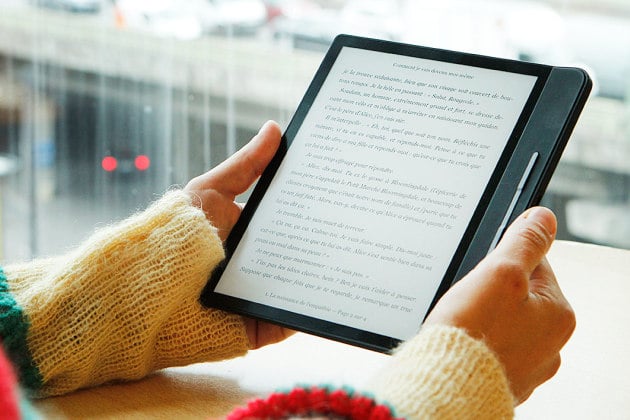

A halfway house, perhaps, is the ability to flip from the usual dark text on a light background to the reverse. This has been such a standard feature of ebook readers for so long that its absence here is surprising. One is the ability to change the colour temperature to make reading at night easier on the eye. SEE: Technology in education: The latest products and trends (free PDF) (TechRepublic) Kobo even makes a reasonable stab at getting over the ebook reader issue of being unable to flick back and forth as you might with a printed book: long-pressing the bottom left and right corners to speed-page forwards and backwards gives a passable approximation of skimming a paper book. More comprehensive reading settings are accessed via the cog tool on this menu. You can also see detailed in-book statistics - how long until the book is read, how long you need to read to finish the current chapter and how long to read the next one, and a graphical representation of your progress through the book. You can change font size, line spacing, margin size, justification and toggle auto rotation on and off, as well as set the front-light brightness. Images: Sandra Vogel / ZDNetĪdjustments are as you'd expect from an ebook reader. Settings and statistics for ebook reading. Alternatively check your own local authority's website for help.
#Kobo forma note taking software
That facility is highlighted right on the home screen of the Kobo software on the Elipsa, and if you already have the required information and OverDrive account setup you can log in right away. Unlike Amazon's Kindles, Kobo devices have built-in support for OverDrive, Pocket and Dropbox, and can be used to read ebooks borrowed from public libraries.
#Kobo forma note taking for android
Kobo has a well-established online bookstore, and like its main rival Amazon there are free apps for Android and Apple devices so you can take your ebook reading with you on an Android tablet or phone, and on iPhone or iPad, with the ability to synchronise your place across devices. I looked at the reMarkable 2 E-Ink tablet earlier this year, for example, but this is the first time ebook reading and note-taking have been combined in a single device, for the UK market at least. The Kobo Elipsa has an E-Ink Carta screen, and this technology has previously been used to make devices that can accept handwriting. The Kobo Elipsa comes with a stylus and a cover for a price of £349.99 in the UK, or $399.99 in the US. While arguably living somewhat in Amazon's shadow, Kobo has now done something Amazon has not - released an ebook reader that can accept handwritten notes. Last year I examined the Kobo Nia, a strong entry-level device, and back in 2018 reviewed the Kobo Forma, which has, until now, been the Kobo flagship device and a competitor for Amazon's Kindle Oasis. Kobo's online store sells e-versions of textbooks and other reading materials that may be required for classes, making this device an ideal all-in-one option.Kobo has a track record of producing serviceable ebook readers. If you're the kind of person who likes to mark up their readings, the Kobo Elipsa e-reader tablet is a fine alternative to printing out all of your readings over a semester and then throwing out hundreds of pieces of paper every semester. So, I have an intimate understanding of the e-reader market in 2022.

I have also tested all of the latest e-reader models from Amazon, Rakuten (Kobo), and Barnes & Noble (Nook). I was also a theater student, so I read a lot of plays whenever I was assigned a play or a reading, I would either print out the 40-70 page document, skim through it so as not to write inside a copy I didn't own, or rewriting entire pages into a notebook so I could mark it up. Compiling your reading materials digitally would cut down on the amount of pages you'd have to print out and carry around.Īs a recent college graduate, I wish I'd had this kind of device when I was in my particularly reading-heavy classes, because I'm the kind of reader and student who likes to annotate everything with my own notes and understanding of the piece.

Textbooks, PDFs, and articles can quickly pile up and, once a semester ends, you're stuck with stacks of paper you'll likely never need again. For most college students, a huge part of those four years includes reading.


 0 kommentar(er)
0 kommentar(er)
